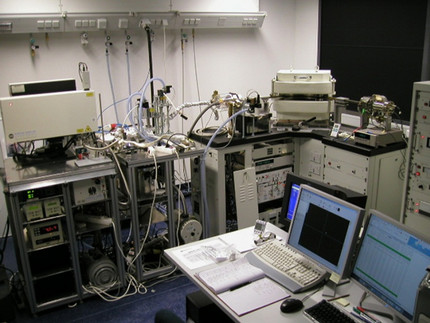Ar/Ar Geochronology Laboratory
The 40Ar/39Ar dating method is a modification and improvement of the 40K-40Ar method. The utilised decay system is the electron capture by a 40K parent nuclide and the production of a 40Ar daughter nuclide with a decay constant (Λe) of 0.581 × 10-10. In addition, beta-decay of 40K to 40Ca also occurs with a decay constant (Λb) of 4.96 × 10-10, but this branch is not used. For the K-Ar method, direct determination of potassium concentrations on sample aliquots is necessary. In contrast, for the 40Ar/39Ar dating method potassium concentrations are determined indirectly by irradiating the rock or mineral samples in a flux of fast neutrons in a nuclear reactor, resulting in the 39K(n,p)39Ar reaction which produces 39Ar nuclides. With the J value and decay constants for electron capture and beta-decay, the 40Ar/39Ar age is calculated as follows:
The J value is a combined parameter incorporating the conditions of the neutron irradiation and which is obtained from simultaneously irradiated standard mineral samples of known age.
Due to the long half-life of 1.25 × 109 years of 40K, the 40Ar/39Ar method can generally be used to determine ages ranging from the age of the Earth to a few ten thousand years before present.
Our present 40Ar/39Ar dating system (see photo at the top of this page) includes:
(1) a Micromass 5400 high sensitivity-low background sector-type noble gas mass spectrometer,
(2) a New Wave Research DualWave laser system comprising a CO2 continuous laser and an UV pulsed laser, and
(3) an ultra-high vacuum metal purification line which includes Zr-Al SAES alloy getters and a cold trap.
The purification line is mainly designed by Dr. Masafumi Sudo, leader of the 40Ar/39Ar laboratory, and is optimised for the analysis of tiny amounts of argon gas released by laser application. A single online analysis from laser heating of a sample to the analysis of the argon isotopes takes approximately 25 minutes. Using the CO2 laser, stepwise heating analyses of grain samples from 0.1 mg to a few tens of mg have been performed in the Potsdam laboratory. In section samples, the UV pulsed laser is able to ablate spots with minimum diameters of a few tens of micrometers.
Sample irradiation is presently performed at the Cadmium-Lined In-Core Irradiation Tube (CLICIT) at the Oregon State University TRIGA reactor (OSTR), USA. Considering the neutron flux of 2.47 × 1013 n/cm2/s of CLICIT, the samples are irradiated for, e.g., just four hours in order to produce enough 39Ar atoms from 39K. Grain samples (e.g. mineral or groundmass separates) or polished thick section samples are wrapped in Al foil and subsequently loaded into a sample-container made of 99.999 % pure Al. Finally, this sample container is irradiated in the Cd-lined tube. Following the irradiation, samples are left to cool down for a few weeks at OSTR, then would be sent back. Finally, argon isotope analyses are performed at the 40Ar/39Ar laboratory in Potsdam.
The 40Ar/39Ar ages are obtained as a relative age against a neutron flux monitoring mineral standard, Fish Canyon tuff sanidine, which is irradiated together with samples of unknown ages. The accuracy of the system has been examined and confirmed by the analyses of some reference materials, such as SORI93 biotite (K-Ar age: 92.6 ± 0.6 Ma; Sudo et al., 1998) or HD-B1 biotite (K-Ar age: 24.21 ± 0.32 Ma; Hess and Lippolt, 1994), shown in the figures below.
Results for SORI93 biotite and HD-B1 biotite by stepwise heating.
If you have interest in our 40Ar/39Ar laboratory, please contact Dr. Masafumi Sudo (laboratory leader), Professor Patrick O’Brien or Dr. Martin Timmerman (radiation officer) in our institute.
References
- Hess, J. C. and H. J. Lippolt (1994): Compilation of K-Ar measurements on HD-B1 standard biotite, 1994 status report. Phanerozoic time Scale, Bull. Liais. Inform. IUGS Subcomm. Geochronol., 122, Paris, 1993
- Sudo, M., K. Uto, K. Anno, O. Ishizuka and S. Uchiumi (1998): SORI93 biotite: A new mineral standard for K-Ar dating. Geochem. J, 32, 49-58

